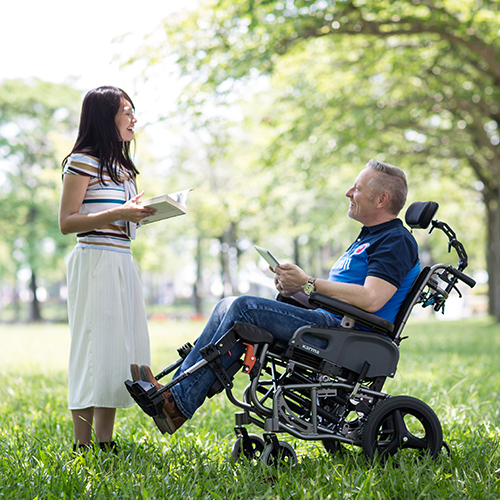
Why Consider Tilt-in-Space as a Solution?
16 October, 2020
Written by Allied Medical
Tilt-in-space on manual or powered wheelchairs has been used for many years now around the globe. Assessors and end-users alike, are aware of the outcomes that can be achieved, that cannot be obtained when using a traditional seating system for users who are unable to independently shift their weight or change positions while seated in an upright position.
When seated, a person often moves up to 30 times an hour to shift their weight to a different position and remain comfortable. Those suffering from conditions including cerebral palsy, head or spinal cord injuries or muscle wasting conditions may not have the ability to do this.
Pressure reduction is often regarded as the main benefit of tilt-in-space. When seated correctly in a static wheelchair, an individual’s weight is supported by three surfaces - the seat, the footrests and the armrests, with the majority being supported by the seat. This can result in increased pressure on the pelvic area, a reduction in capillary action and a risk to skin integrity. By using a wheelchair or powerchair equipped with tilt-in-space, a person’s weight is rotated backwards and distributed over a larger surface area as it now includes the backrest. As a person’s weight is a constant, the pressure exerted on the seat is now reduced allowing greater capillary action and reducing the risk to skin integrity.
The tilt-in-space action can be either manual and applied by a caregiver or powered and managed by the user. Ideally, tilt will be adjusted every 15 to 20 minutes to shift pressure away from any one point. The action of sliding forward, and resulting shear force, in the seat is also greatly reduced in a tilted position which reduces the risk of weight-bearing on the sacrum and the associated skin integrity issues. A tilted angle of only 20 degrees greatly reduces shear and 45 degrees plus will eliminate it.
Stability and balance are also increased in tilt which will result in a greater feeling of security for the user as it reduces the feeling of falling forward especially when travelling down a slope or incline. Tilt-in-space when used in conjunction with elevating leg rests and recline can also help with the management of oedema as it makes it possible to position the legs level with or above the heart.
In conclusion, adding this simple action to a manual or powered wheelchair can provide dramatic benefits for your client.
Key Benefits of Tilt-in-Space
- Allows for safe weight shifts and position changes
- Reduces the risk of skin breakdown by shifting pressure from the seat to the back
- Increases sitting tolerance due to greater comfort and less pain
- Reduces the need for users to be transferred in and out of their chair throughout the day to relieve pressure
- Provides appropriate positioning for clients who are at risk for respiratory or digestive complications
- Provides a better position for clients who are at risk of dizziness, increases in blood pressure or loss of consciousness
- Allows a change in position without the risk of shear forces due to the body remaining in the same position the entire time
Allied Medical has a range of tilt-in-space manual wheelchairs and powerchairs. Chat to your Business Territory Manager or our Customer Care Team for further information.
Tilt-in-Space Powerchairs
Jazzy 623 2.0, Quantum Edge 3 and Quantum Edge 3 Stretto
Tilt-in-Space Manual Wheelchairs
Ki Mobility Liberty, Ki Mobility Focus and Karma VIP2
Please note, there are times when the tilt-in-space option may not be the correct or safest option. This includes those with swallowing difficulties and those who require the use of a tray or a catheter.
